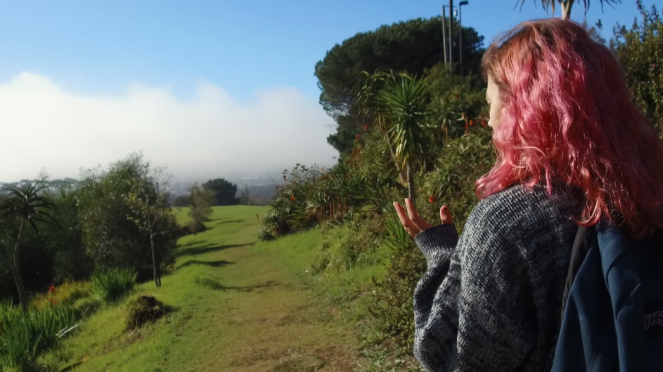“A strange girl picked up a piece of my hair and put it in her mouth, saying, ‘It looks like bubble gum, I wanna try eat it.’ I was horrified.” – Hairstylist, Gabrielle Oelofsen
If you sit on the University of Cape Town’s famous Jammie steps – the ultimate place for procrastination, soaking up sunlight, and watching people trip – you’ll see all sorts of humans; amongst them are unicorns, phoenixes, and mermaids. When I started at UCT, the view from Jammie wasn’t as colourful. There were a few, but the growth over the past 4 years has been exponential.
Hairstylist and Youtuber, Gabrielle Oelofsen, has had every colour of the rainbow in her hair. Among UCT students with unnaturally coloured hair, she shared her experiences over the past few years. One of these being the time someone tried to eat her hair. Amidst the horrifying and hilarious experiences, I find the language and dialogue around colourful hair intriguing, being a dye hard myself for over 3 years.
Gabi epitomises how addictive dyeing one’s hair becomes. She relates her first fashion colour choice, “The second I finished high school I grabbed the nearest pot of pink dye and covered my hair with it. Within the last five years, my hair has been every colour of the rainbow.”
The people with fashion colours at UCT all show incredible excitement over their colourful hair. Gabi describes her euphoria by saying that her heart felt light as a feather whenever she catches a glimpse of herself in the mirror. Many with colourful hair will tell you that in the first couple of days, when you see your reflection you get a bit of a shock. Annie and Alix, who make up two thirds of their Powerpuff Girls gang, find bundles of pink and blue hair all over their bathroom, amidst the stained towels.
“My hair is how I express who I am and what’s inside my heart,” Gabi says. UCT student, Alix Hodge, also views her hair as a form of self-expression. She likes being ‘the girl with blue hair’ since she has control over that identifier.
Anyone who has strayed from their natural hair colour will understand the dread that grows out with your roots. Alix feels “offended by [her] own hair”, she addresses the sea around her face, “Why are you not growing blue? You’ve been blue for long enough now, surely you’ve mutated.”

The attitude toward unnaturally coloured hair has changed rather drastically over the past few years, as it rises in popularity. “I went from that weird pink-haired girl to the girl that couldn’t change her hair without someone changing theirs,” Gabi explains. It has yet to be all sunshine and rainbows. “Back in the day, I got a lot of negative feedback,” Gabi says as she relates how a client wouldn’t let her touch her hair. The client called her many rude names, including a “small freak with pink hair”. The client then began insulting Gabi’s character and upbringing, based on her appearance. These attitudes may have decreased over time, but people continually ask ‘how are you going to get a job?’ and find it imperative to tell you that ‘you look better with natural hair.’ Most students I spoke to complained about how people just touch, grab, and even pull their hair without permission. Though one interviewee added, “Ha! Joke’s on them, I haven’t washed it ages!”
As a professional, Gabi saw a rise in clients while her hair was blue. “I became a walking advertisement.” She is excited by how acceptance has grown since “it has opened doors for professional colour houses to expand their range and improve the way that fashion colours are formulated.”
Mermaid, unicorn, phoenix, fairy, grape juice, galactic empress, Princess Bubblegum. These are a few of the phrases I picked up around UCT campus from dye hards. Gabi says children often say the best things: “I’ve been called a mermaid for my blue hair, a fairy for pink, ghost for white and green, and Barbie when blonde.” This language is cropping up increasingly, particularly mermaid. Blends also appear on social media, such as ‘mermicorn’ and ‘merbabe’.
“It’s exciting to see more and more people get creative and express who they are through their hair.” Similarly, I am excited to see how these people and others are responding to this and the ways in which they describe new colours. With holographic and oil-slick hair, the future in language surrounding fashion colours is looking bright. But if I read ‘glow-in-the-dark’ one more time for hair that glows under blacklight, I might just spitefully invent dye that glows in the dark.
Gabi hopes the trend of colourful hair doesn’t ‘fade away’ soon, since it makes her job fun and helps the industry advance. “These days I’m back to my Lady Gaga blonde as it suits how I feel inside best but I wouldn’t be surprised if my hand starts itching towards the pink again,” Gabi concludes. As days get darker and drearier at UCT, I hope to see more bursts of colour this winter.


This is such an inspiration for people like me who yearn to experiment with this kind of self-expression, but are just too scared to take the leap. The furthest I’ve ever gone was a full head of dark purple, but I would love to do pink and blue as well.
LikeLiked by 1 person